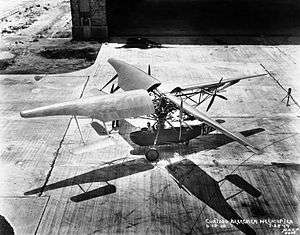Curtiss-Bleecker SX-5-1 Helicopter
| Curtiss-Bleecker Helicopter | |
|---|---|
 | |
| Role | Helicopter |
| National origin | United States of America |
| Manufacturer | Curtiss Aeroplane and Motor Company |
| Designer | Maitland B. Bleecker |
| First flight | 1926 |
| Number built | 1 |
| Unit cost |
$250,000 in 1930 |
The Curtiss-Bleecker Helicopter was an American prototype rotary wing aircraft, introduced in 1926. The thrust of the aircraft was distributed from a central mounted engine through shafts to propellers mounted on each rotor blade.
Design and development
The Bleecker Helicopter was designed by Maitland B. Bleecker, a junior engineer from the National Advisory Committee for Aeronautics. The aircraft was constructed by Curtiss Wright for $250,000 over the course of four years at Garden City.[1]
The aircraft featured a rotary wing design with a single engine. Each rotor, painted silver and yellow, had an individual propeller for thrust and a trailing control surface called a "stabovator" to change pitch of the rotor. The aircraft was controlled by a stick that operated like a modern helicopter collective control. Yaw was controlled with a "Spin Vane" that used downwash from the rotor to pivot the aircraft with foot pedals.[1]
Operational history
Testing on the Bleecker Helicopter was stopped after the failure of a drive shaft on a test flight in 1929.[2] By 1933 the project was abandoned following vibrational issues in further tests.[3]
Specifications
Data from NASA
General characteristics
- Capacity: 2
- Wing area: 370 sq ft (34 m2) Area of rotor blades
- Empty weight: 2,800 lb (1,270 kg)
- Gross weight: 3,400 lb (1,542 kg)
- Fuel capacity: 30 US gallons (114 litres)
- Powerplant: 1 × Pratt & Whitney Wasp radial piston, 420 hp (310 kW)
Performance
- Maximum speed: 70 mph (113 km/h; 61 kn)
- Rate of climb: 1,000 ft/min (5.1 m/s)
See also
References
| Wikimedia Commons has media related to Curtiss-Bleecker SX-5-1 Helicopter. |
- 1 2 "New Plane May Fly Straight Up in Air." Popular Science Monthly, September 1930, pp. 20-21.
- ↑ Bowers, Peter M. (1979). Curtiss Aircraft, 1907-1947. Naval Institute Press. ISBN 978-0-87021-152-2.
- ↑ Leishman, J. Gordon (24 April 2006). Principles of Helicopter Aerodynamics with CD Extra. Cambridge University Press. p. 27. ISBN 978-0-521-85860-1.